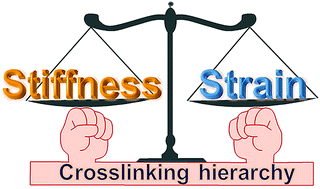Mussel byssus cuticle-inspired ultrastiff and stretchable triple-crosslinked hydrogels†
Abstract
Applications in the harsh environment require hydrogels with ultra-stiffness, toughness, and stretchability. However, it remains a challenge to increase the elastic modulus without sacrificing the maximum elongation of hydrogels, because of the trade-off between stiffness and extensibility. Inspired by the crosslinking hierarchy of mussel byssus cuticle, here, we report a strategy to fabricate an ultra-stiff, tough and stretchable triple-crosslinked (TC) hydrogel. The polymer is crosslinked by chemical crosslinker at first, subsequently by introducing a polyphenolic compound, tannic acid (TA), and metal ions. The hydrogen-bond-based network between the polymer and TA works as an extensible and energy-dissipative network, mimicking the matrix of the cuticle, while the higher crosslinked domains formed by the coordinate bonds between TA and metal ions contribute to the stiffness. The triple-crosslinked hydrogel exhibits two orders of magnitude increase in stiffness (E = 58 MPa), but without sacrificing the maximum elongation (ε = 850%), compared with those of metal-free hydrogels (E = 0.18 MPa, and ε = 860%). The combination of ultra-stiffness, toughness, and stretchability in hydrogels is successfully achieved through leveraging the hierarchically cross-linked network based on hydrogen bonding and coordination bonding. Moreover, utilizing the wide distribution of bonding strength of coordination interaction, the mechanical properties of triple-crosslinked hydrogels can be manipulated by using different kinds of catechol-metal coordination.



 Please wait while we load your content...
Please wait while we load your content...